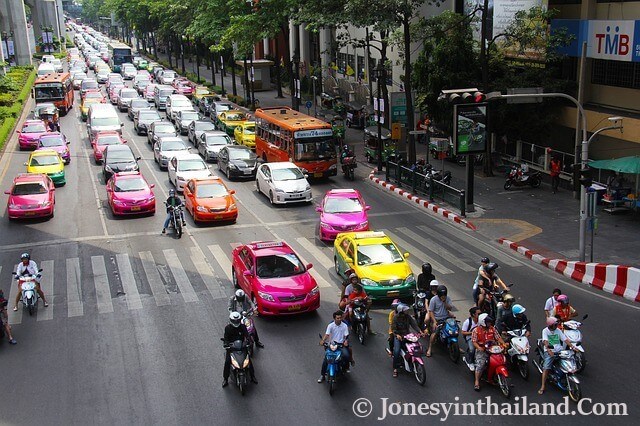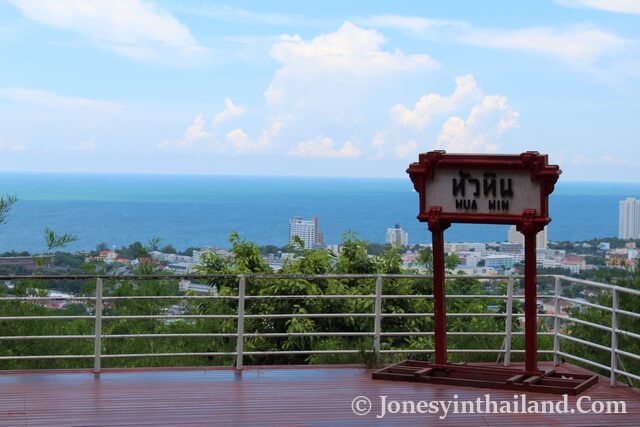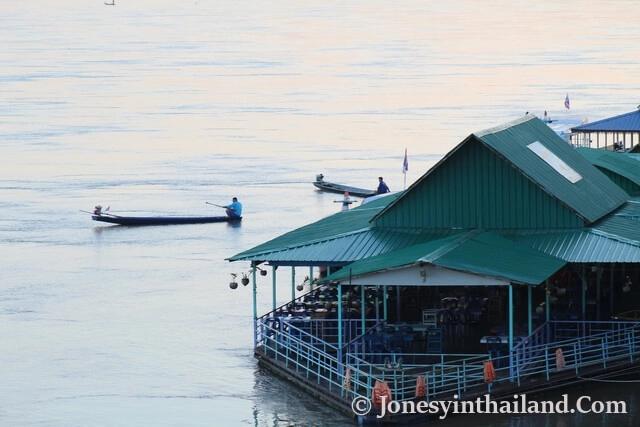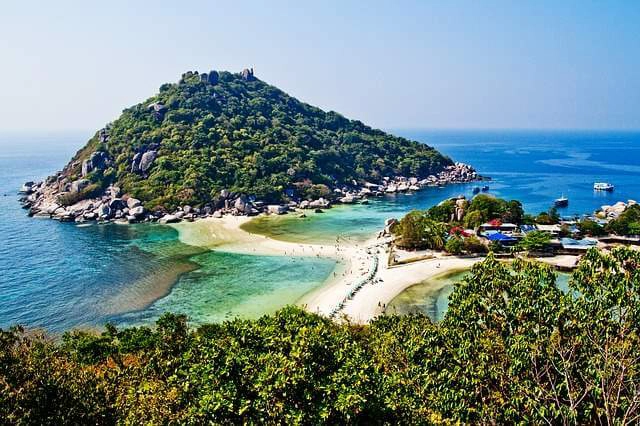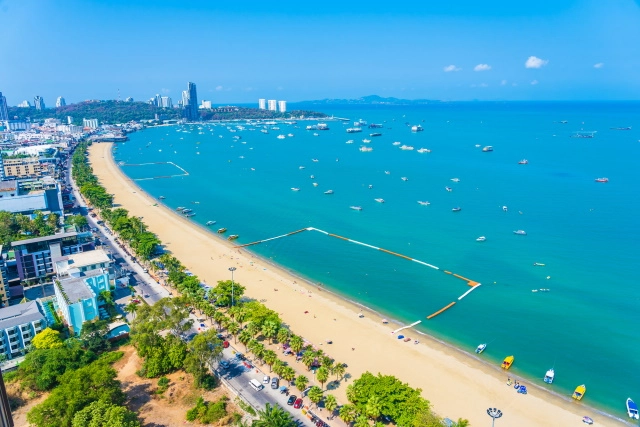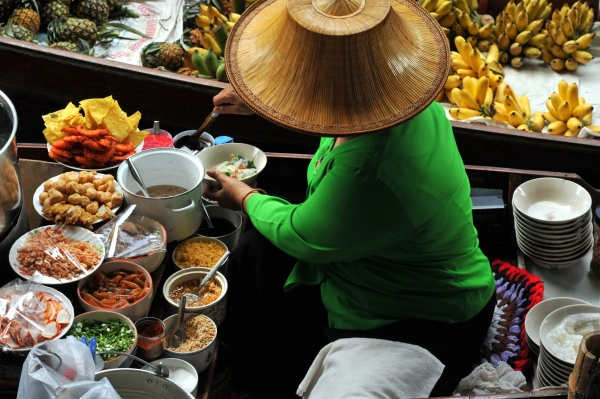13 Best Things to Do in Kanchanaburi – Our Recommendations
-- Last Updated on February 13, 2023 by Jonesy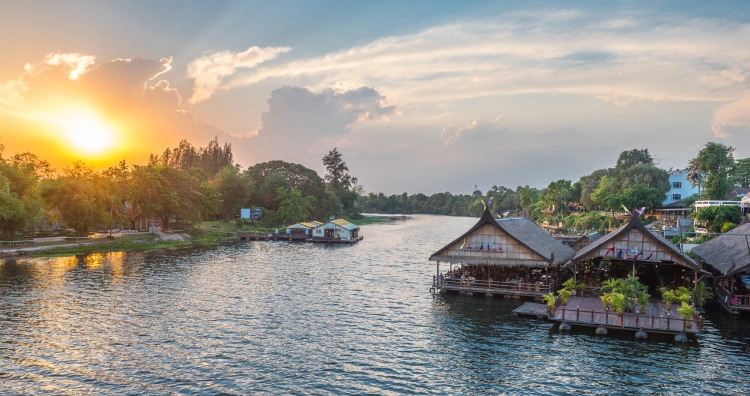
Kanchanaburi is the third-largest province in Thailand, located in the western regions at the confluence of the Mae Klong River. The province also borders Myanmar, and is 2-3 hours from Bangkok by road (a bit longer by train).
The region has a few dark and disturbing elements to its historical past courtesy of the occupying Japanese during World War II. The area has many historical aspects and quite a few are related to this period in history by way of various sites and museums.
Kanchanaburi is also a great place for adventurous types likely to be inclined towards the fantastic wilderness landscapes and natural beauty. The landscape features a few great waterfalls and some excellent recreation opportunities.
Thus Kanchanaburi is a popular and picturesque outdoor exploration spot with many natural and cultural attractions to add to the historic element. Let’s take a closer look at 13 things to do in Kanchanaburi.
1. Erawan National Park
Erawan park and falls became Thailand’s 12th National Park close to 50 years ago. It was named after the three-headed white elephant of Hindu mythology due to the top tier of the amazingly-picturesque, 7-tiered Erawan Falls being thought to resemble an elephant head.
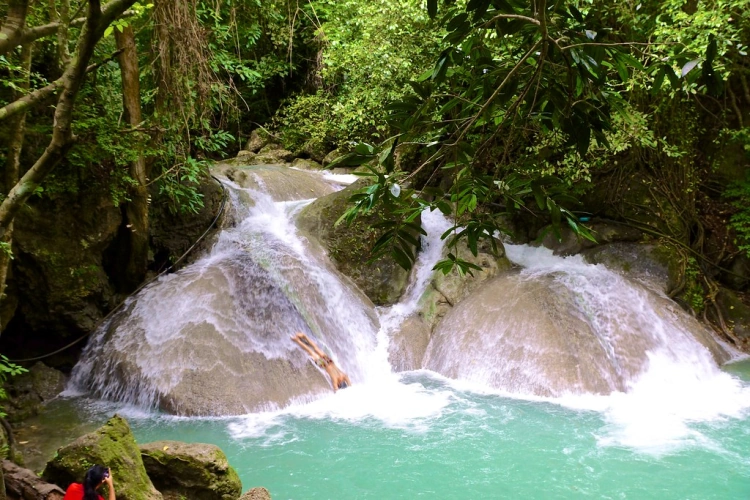
The falls has a few accompanying emerald green ponds and is the main attraction within the park. It presents some stunning scenarios, not to mention the chance to take a dip. There are also a few impressive caves within the park, including some really long ones running the length of the roads around the park.
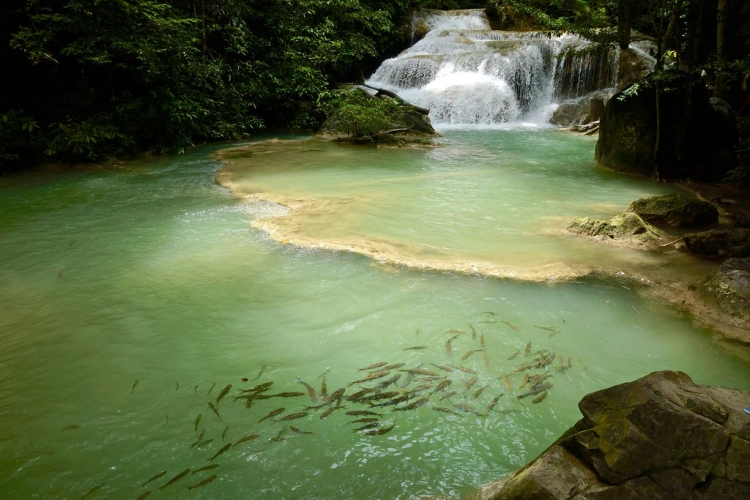
Most of the national park is a mix of deciduous forests with a few dry evergreen ones higher up. It is largely surrounded by hills and plains-type regions with a few streams running through, and with elevations up to 3,000 feet it’s no surprise this is a popular hiking area.
— Address: Tha Kradan, Si Sawat District, Kanchanaburi,71250
— Hours of operation: 8 am-4.30 pm daily
2. Bridge on the River Kwai (Khwae)
The Bridge is known in English as being over the River Kwai thanks to the 1957 movie named after and featuring the structure. In Thai though, you’ll find it is spelled and pronounced ‘Khwae,’ so expect a few puzzled looks if you try the English pronunciation (which can mean buffalo in the Thai language amongst other things, depending on intonation).
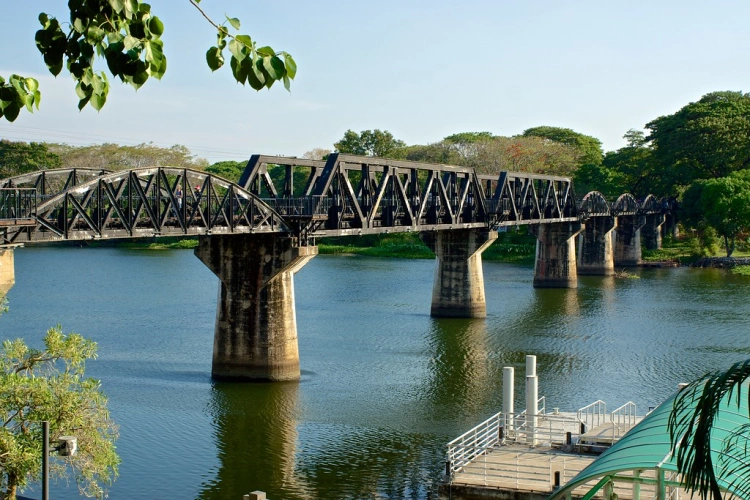
The bridge once formed part of the Thai-Burmese railway known as ‘Death Railway’ due to the countless numbers of captured allied prisoners who died while being forced to undertake the work. The bridge was actually made in Japan and shipped over for reassembly by war prisoners, playing a key role in the rail link between Thailand and Burma.
Although you can walk across the short stretch of track on the bridge, it is actually still operational–a fact that will become more obvious when you hear the sound of an approaching horn. These days the bridge is surrounded by a few things like a museum, a couple of cafes, market stalls, and shops, and one or two ancient steam locomotives.
— Address: Mae Nam Khwae Road, Tha Makham Mueang, Kanchanaburi, 71000
— Hours of operation: 24-hour open location
3. ElephantsWorld
ElephantsWorld was established back in 2008 in response to the small number of elephants wandering the banks of the River Kwai. Many were old or injured in some way and in need of some care and attention. ElephantsWorld was set up initially as a place for the animals to find food and a safe haven.
The team behind the project started out with fund-raising, but as word spread regarding their efforts with the elephants, eco-tourism pointed the way toward the camp’s sustainability. This has allowed Elephant World and its staff to grow, expand, and develop along with the growing community of elephants, which now numbers more than 30.
Thankfully this is not the kind of place where you are likely to find the animals involved in anything close to the ill-treatment which does still go on in Thailand. Here though, the team have a mission to care for the elephants as best they are able, and they make every effort to ensure the visitor experience is informative and meaningful.
— Address: 52 Moo 4, Ban Nong Hoi, Amphoe Mueang, Tambon Wang Dong, Kanchanaburi, 71190
— Hours of operation: Morning sessions are 8.00 am-11.00 am, and afternoon sessions are between 4.00 pm and 8.00 pm. Full-day sessions are also available, but bookings are recommended.
4. Wat Ban Tham
Just slightly down the river of the main part of Kanchanaburi is Wat Ban Tham–otherwise known as the ‘Dragons Head’ Temple. This might have something to do with the rather well-thought-out and colourful staircase that forms part of the temple’s impressive and unique architecture and leads up into what looks like the mouth of a giant dragon.
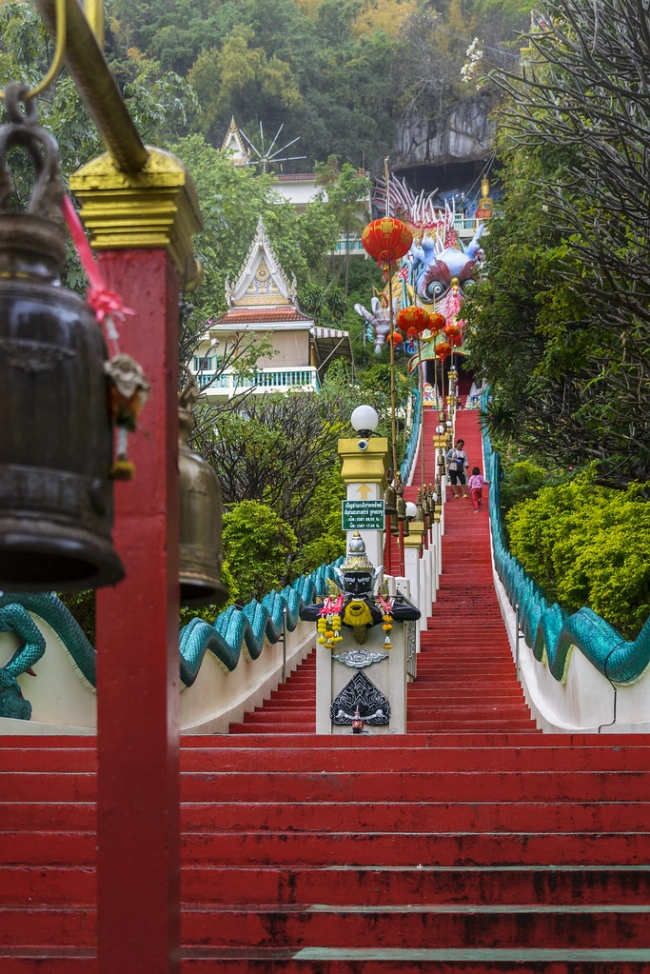
From this spot you continue into the ‘body’ of the beast, which is resplendent in temple murals. There are various caves in the temple, and it also contains a Golden Chedi and other features common to temples in the region, such as prayer bells and statues. You can also get some amazing views of the surrounding countryside from here.
— Address: Khao Noi Tha Muang Kanchanaburi 15130
— Hours of operation: 7.30 am-5.00 pm
5. Hellfire Pass & Memorial Museum
The historical railway building theme is highlighted at Hellfire Pass in a different way. This is a hiking trail that gives participants a feel for the kind of conditions those undertaking the work would have experienced.
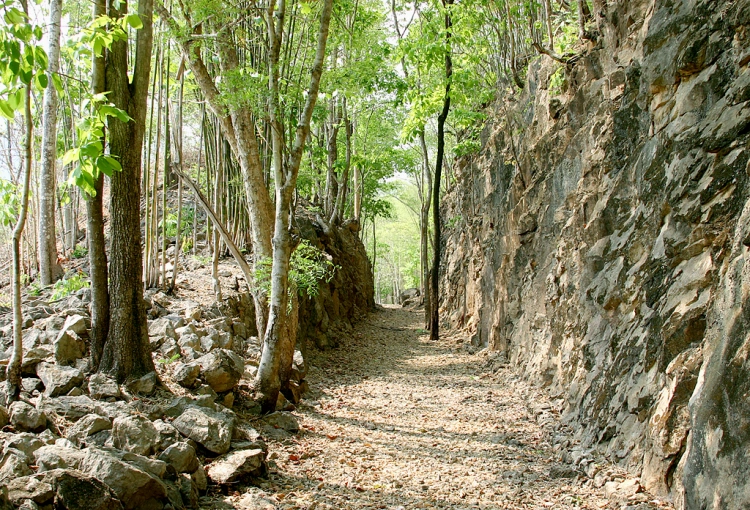
The hike is the recommended way to experience site via the Walking Trail that serves as a memorial for a time when this tranquil jungle region was anything but that.
It’s worth being prepared for some serious walking if you come to the site, and there is a 4 km section of the former tracks open to the public.
The Hellfire Pass Memorial commemorates close to 100,000 POWs and local labourers who lost their lives during the railway’s construction. The Hellfire Pass Interpretive Centre features various displays, exhibits, and a movie about the railway.
— Address: Moo 11 Sai Yok (near Km. 66 of the Sai Yok-Thong Pha Phum Road along Highway No. 323), Kanchanaburi 17000
— Hours of operation: 9 am-4 pm Daily
6. The Death Railway Centre and Museum
The Death Railway and its haunting legacy harks back to WWII again and the Japanese Army’s forced labour for the construction of the railway line to Burma. The line was completed in 1943 and still operates routes from Bangkok to Nam Tok.
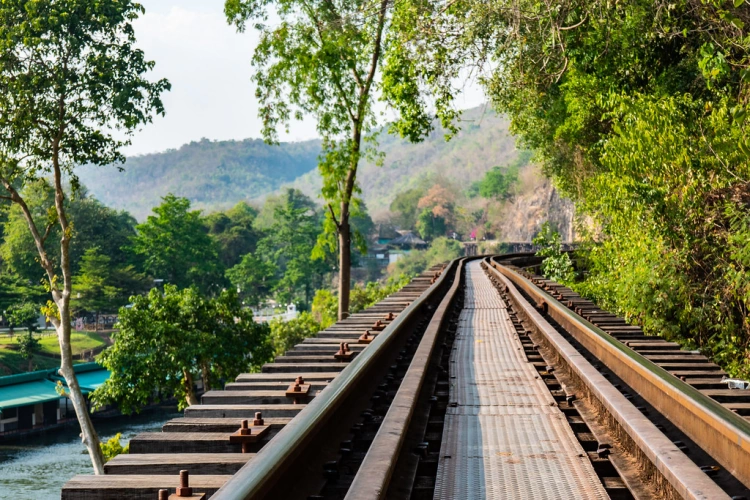
The start of the railway is at Nong Pladuk (80 km west of Bangkok) and from there it heads northwest to Kanchanaburi, over the River Kwai Bridge. From Nam Tok, the trackbed is disused, but it nevertheless leads to the infamous Hellfire Pass and eventually into Myanmar.
What was once a former station is now home to the Thailand-Burma Railway Centre. The facility has two floors, with part of it reserved for the Death railway museum and its emotionally stirring exhibits and information related to the events.
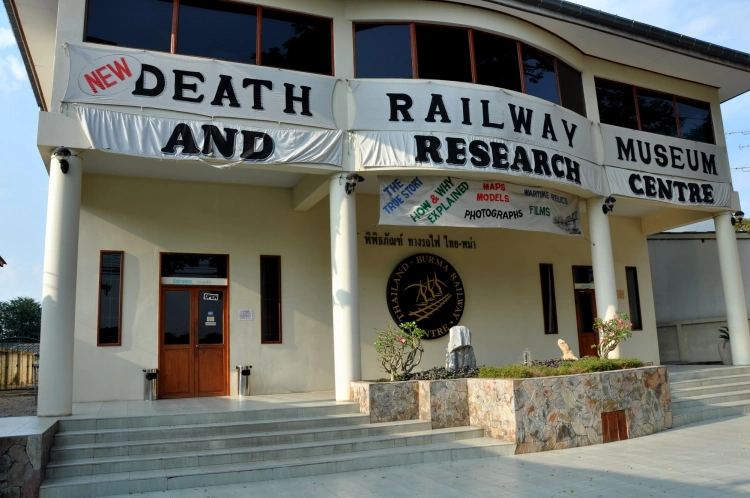
— Address: 73 Jaokannun Road, BanNua, Amphoe Muang, Kanchanaburi 71000
— Hours of operation: Daily from 9 am to 4 pm
7. Kanchanaburi War Cemetery
This is the site that commemorates the 13,000 or so POWs that lost their lives in the region during this horrific time.
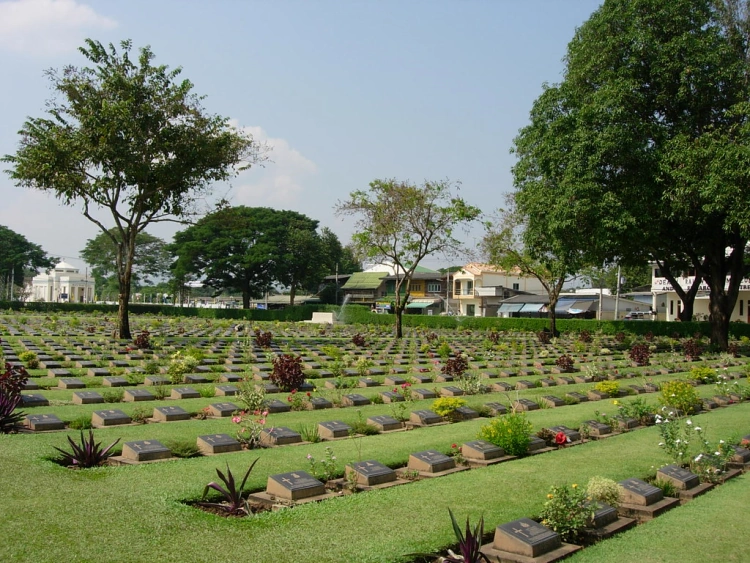
Located opposite the main railway station, the memorial grounds are obviously not the cheeriest of places and feature actual artefacts and exhibits from the prisoners who had different nationalities including Australians, British and Dutch.
— Address: 284/66 Sangchuto Road, Ban Tai, Mueang Kanchanaburi District
— Hours of Operation: Daily between 8 am and 5 pm
8. Kaeng Lawa Cave
The Kaeng Lawa Cave can be found in the vicinity of the Kwai Noi River section. The cave is an amazing 500-metre long cavern overlooked by huge mountains and surrounded by jungle. It features multiple chambers, impressive other-worldly stalagmites and stalactites, and Buddha statues throughout.

The various chambers of the cave have different names and features such as the music chamber, the throne chamber, and the curtain chamber. Keep your eyes peeled for the tiny Khun Kitti bat. This is apparently the smallest bat ever known with a wing span of not more than 10cm, and it calls the Kaeng Lawa Cave home.
It takes around a couple of hours to get the best of the caves and there is an entrance fee of around 200 baht (although some of the official sites report no fees).
— Address: Wang Krachae, Sai Yok, Kanchanaburi 23000
— Hours of operation: 9.00 am-4 pm
9. Safari Park Open Zoo
The Safari Park Open Zoo is a large facility featuring eight different zones. Various animals can be observed living in close-to-natural-style habitats, and visitors get to witness crocodiles, giraffes, lions, tigers, and bears, to name just a few of the animals.
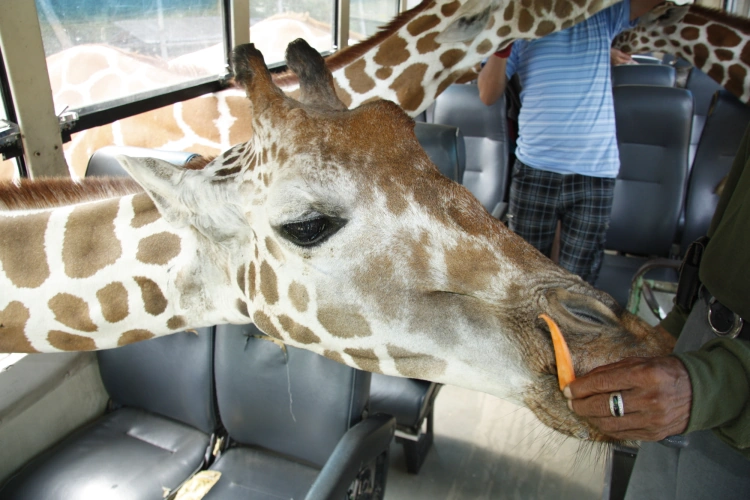
The Safari Zone involves driving through various zones and engaging the animals at various distances. Feeding carrots to deer, zebras and giraffes is a highlight for many kids.
Like many zoos and other facilities in Thailand this one has come under some criticism (mainly from ex-volunteer workers) for its behind-the-scenes treatment of animals. Unfortunately, it’s a fact that in Thailand there are still a lot of questionable practices when it comes to the treatment and welfare of animals.
Visitors can witness crocodile and elephant shows which might be considered no-no’s by various animal welfare organisations, although there seem to be plenty of oblivious families enjoying the fun.
Under Review: We are allowing the zoo some time to recover after the covid restrictions that affected every tourism business in Thailand, and will visit by the end of 2023. If we find animal welfare issues we will remove this attraction from the list.
— Address: 99 Tambon Nong Kum, Amphoe Bo Phloi, ChangWat Kanchanaburi 71160
— Hours of operation: 9.00 am-5.00 pm
10. JJ Night Market
There’s only really one-night market in Kanchanaburi and this is it, right next to the railway station. The layout is divided into two main areas–one mainly for food and beverage vendors and the other for clothing and accessories.
Like any decent night market in Thailand the prices are reasonable and the food and snack options plentiful, and there are likely to be a few bargains to be had.
— Address: Tambon Ban Tai, Amphoe Mueang Kanchanaburi, Chang Wat Kanchanaburi 71000
— Hours of operation: Every evening, 5.00 pm-10.00 pm
11. Wat Tham Suea (Tiger Cave Temple)
Another one of Kanchanaburi’s many impressive temples comes by way of this visually-stunning, Thai-Chinese-style construct on a hilltop. Located in Tha Mueang district, Wat Tham Suea is the region’s largest temple, renowned for its spaciousness and Chinese-influenced architectural style, not to mention the 18-metre high Buddha image.

To get to the top you can either climb the 157 steps or opt for the ageing cable car with a 10 baht ticket. From the top you’ll be rewarded with some excellent panoramic views of the Mae Klong river surrounded by rice fields and a mountain backdrop.
The various elegant architectures take on a different perspective as what is the largest Buddha image in Kanchanaburi. You can also check out an impressive-looking, 9-storey, octagonal pagoda which is a bright orangey colour but you’ll have to descend the hill again to visit the tiger cave which is at the bottom along with various Buddhist artefacts.
— Address: Moo 3 Tambon Muang Chum, Tha Mueang, Kanchanaburi
— Hours of operation: 8.00 am-5.00 pm
12. Wat Tham Pu Wa
Another impressive regional temple featuring some Khmer-style architecture and a 2-storey cave, Wat Tham Pu Wa is also known as something of a meditation retreat.
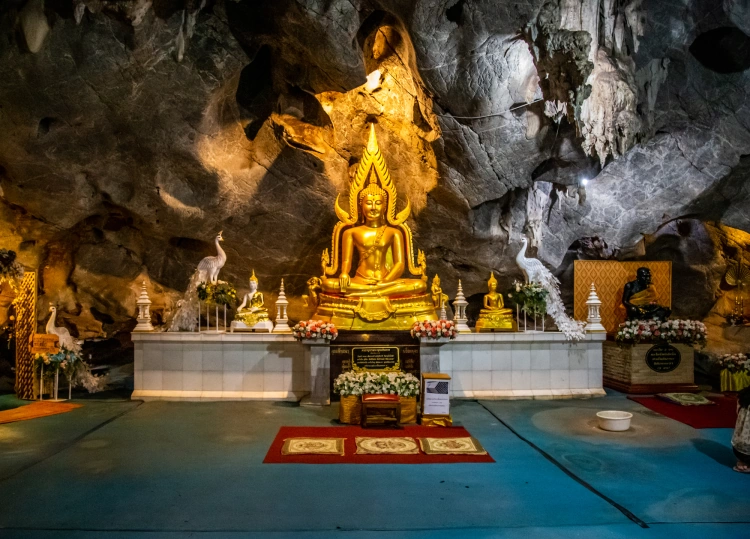
At the temple cave entrance you can see the amazing configurations of natural stalagmites and stalactites. There is a small, chimney-type opening in the cave as well that lets the light shine in on the many Buddha images and relics.
— Address: Moo 7 Mueang Kanchanaburi
— Hours of operation: 8.00 am-5.00 pm
13. Hintok River Camp
This ‘river tented camp’ may be of interest to explorers in the area who might fancy stopping over. It is within the vicinity of Hellfire Pass and other attractions and features amazingly-elegant and spacious canvas tents also known as ‘glamps’.

For those still unfamiliar with the word ‘glamping,’ it’s basically a mix of ‘camping’ and ‘glam’. This means the tent has even got real beds, which may turn out to feel surprisingly comfortable. On top of that there’s a fridge, toilet, shower, air-conditioning, and a front veranda.
— Address: 109, Ban Had Ngew, Tha Sao, Sai Yok District, Kanchanaburi 71150
— Hours of operation: 6 am-10 pm

Mark Philip is a writer and lifestyle enthusiast from the Midlands in the U.K. With a background in martial arts and fitness, Mark upped sticks and headed out to Bangkok to delve a bit deeper into the art of Thai Boxing way back in the 2000s, starting to write initially to fund his daily training and escape the rigours of ESL teaching. Since then Mark has authored e-books, articles, and blogs across a wide range of topics for commercial, educational, factual, health & fitness, lifestyle, wellness, and leisure-based purposes.

